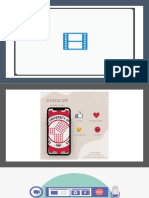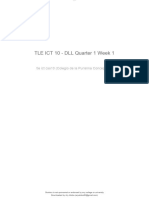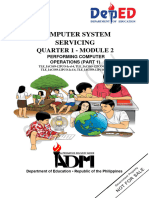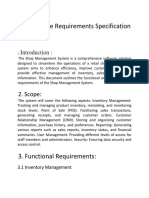0 ratings0% found this document useful (0 votes)
94 viewsCSSPart1 Lesson 1
The document provides guidelines for ensuring occupational health and safety (OHS) when servicing computer systems. It outlines policies and procedures for planning installation activities, installing hardware and software safely, testing installed systems, reporting hazards, and following safety standards for fires, hazardous substances, and exits. Personal safety measures are also described such as wearing protective equipment, discharging static before touching components, and avoiding mixing water and electronics.
Uploaded by
Johnkevin SolomonCopyright
© © All Rights Reserved
Available Formats
Download as PPTX, PDF, TXT or read online on Scribd
0 ratings0% found this document useful (0 votes)
94 viewsCSSPart1 Lesson 1
The document provides guidelines for ensuring occupational health and safety (OHS) when servicing computer systems. It outlines policies and procedures for planning installation activities, installing hardware and software safely, testing installed systems, reporting hazards, and following safety standards for fires, hazardous substances, and exits. Personal safety measures are also described such as wearing protective equipment, discharging static before touching components, and avoiding mixing water and electronics.
Uploaded by
Johnkevin SolomonCopyright
© © All Rights Reserved
Available Formats
Download as PPTX, PDF, TXT or read online on Scribd
You are on page 1/ 38
!
Computer System Servicing
Part 1
TURN ON
SILENT MODE
QUICK GAME
E
S A F E T Y
Lesson 1 Computer System Servicing Part 1
“Planning and preparing Unit Assembly
to ensure OH&S policies and procedures”
Occupational Health and Safety (OHS) Policy – An
Information and communication technology (ICT) student should
know how to behave when working in the computer laboratory, as
well as implement a safe way of accomplishing every task. Safety
practices should be learned early and always adheres in working
with any electrical and electronic device, including personal
computers and its peripherals.
This is for your protection as well as to the people working with you,
and for the devices that you are using. The basis for this process
begins with Occupational Health and Safety Policies.
Occupational safety and health (OSH) is a planned
system of working to prevent illness and injury where you
work by recognizing and identifying hazards and risks.
Health and safety procedure is the responsibility of all
persons in the computer and technology industries. You must
identify the hazards where you are working and decide how
dangerous they are. Eliminate the hazard or modify the risk
that it presents.
Do not work alone so that
there's someone who can
take care of you in case of
emergency.
Always power off the
computer and unplug the
computer before working
on it.
Take away any liquid near
your working area to avoid
getting electrocuted or
accidentally damaging
computer parts.
Be careful with tools that
may cause short circuit.
Always ground or discharge yourself
before touching any part of the
computer.
Do not use excessive force if things don't
quite slip into place.
Clean the area before and after using it to
maintain sanitation and prevent accidents
Hold the components on the edges and do
not touch the Integrated Circuit (IC) parts.
Always wear personal protective equipment
(PPE) in accordance with the organization's OHS
procedures and practices.
Make sure that the pins are properly
aligned when connecting a cable connector.
Contingency measures during workplace
accidents, fire and other emergencies are
recognized.
Use brush, compressed air or blower
in cleaning the computer system.
PLAN AND PREPARE FOR INSTALLATION 01
Observe Occupational Health and Safety
policies and procedures in planning for
installation activity in accordance with
requirements
Familiarize with computer hardware, software
component and other peripherals in accordance
with established procedures on correct
operation and safety policies
PLAN AND PREPARE FOR INSTALLATION 01
Consult appropriate/ technical personnel to
ensure that work is coordinated with others
who are involved in the activity
Obtain materials necessary to complete the
work in accordance with established
procedures
Check the materials received against job
requirements
INSTALL EQUIPMENT/DEVICES (HARDWARE,
SOFTWARE COMPONENTS AND PERIPHERALS) 02
AND OPERATING SYSTEMS
• Follow OHS procedures in installing devices,
systems, networking devices, and peripherals.
• Comply with the requirements in installing
devices, /systems, networking devices, and
peripherals.
• Install computer systems, networking devices
and peripherals in accordance with job requirements.
INSTALL EQUIPMENT/DEVICES (HARDWARE,
SOFTWARE COMPONENTS AND PERIPHERALS) 02
AND OPERATING SYSTEMS
• Perform installation of devices and variety of
operating systems in accordance with customer/client’s
requirements.
• Obtain approval from appropriate personnel before
implementing contingency procedures.
• Respond to unplanned events or conditions in
accordance to established procedures.
• Check the quality of the work undertaken in
accordance with the established procedures.
CONDUCT TEST ON THE INSTALLED 03
COMPUTER SYSTEM
• Follow OHS policies and procedures in
conducting tests.
• Check circuits and systems being isolated
using specified testing procedures.
• Test devices, systems and/or installation to
determine its conformity with the requirements.
OCCUPATIONAL HEALTH AND
SAFETY STANDARDS
Procedure
1. Identify the hazard
2. Clear the area close to the hazard
3. Partition the hazard off or clearly identify
the area to protect other people from harm
4. If the hazard is easily and safely cleared,
then do so
OCCUPATIONAL HEALTH AND
SAFETY STANDARDS
If not…
1. Report the hazard to the appropriate
person (such as teacher in charge, principal
etc.) to obtain assistance
OCCUPATIONAL HEALTH AND
SAFETY STANDARDS
If not…
2. Following clearing of the hazard fill out the
correct documentation to assist in identifying improved
practice to reduce further incidence of hazards.
All hazards must be reported using Accidental Report
form. This enables us to track the kinds of hazards we
have in our workplace, and take action where necessary
to make it safer for all student and clients.
All hazards must be reported using
Accidental Report form. This enables us to
track the kinds of hazards we have in our
workplace, and take action where necessary
to make it safer for all student and clients.
ACCIDENT REPORTS
Forms are used to give specific details
with regards to the accidents happened
in the laboratory during experiments.
Accident reports contain the following
details:
Name of the person injured
Date and time of the accident
Type of injury
First aid given
Action taken to prevent further accidents
HAZARDOUS SUBSTANCES
If the workplace hazard appears to be dangerous to staff
and clients and professional assistance is required:
1.Call the supervisor or manager and advise them of the
problem and the urgency of the matter.
2.Depending on the risk it may be called as an evacuation.
3.Follow the evacuation procedure.
4.The supervisor or manager will call in the fire brigade or
specialized personnel who will deal with the spill.
FIRE EXITS
All fire exits should be kept clear of from obstacles. All
students have a responsibility to make sure that chairs,
empty boxes or any other type of obstacle are not placed
in or near fire exit doorways.
All corridors also need to have equipment stored on one
side only to ensure that in the event of an emergency
there is a clear exit.
FIRE SAFETY PROCEDURE
Each work area has a designated
fire warden, who in the event of a
fire will take charge. They are
recognized by the wearing of a
red hard hat.
If you find the fire
• Assess the danger prior to doing anything.
• If it is safe to move assist anyone in the
vicinity of the fire away from danger.
• If it is possible close the door to the fire
area.
• Call for assistance. Verbally call FIRE,
FIRE, in a loud and clear voice.
If you find the fire
• Break the glass section of the fire alert call
point.
• Call to the switch; ensure you know where the
fire is, any other details that may be of
assistance to the fire brigade. Details could be
size of the fire, cause or type of fire, any people
hurt or trapped, has anyone tried to put it out.
• If safe to do so, attack the fire with the correct
extinguisher or fire hose.
If the designated fire officer is not present,
someone quickly needs to take responsibility and:
• Locate the source of the fire.
• Locate any people.
• Remove all people from the building.
• Once outside do a head count?
• Notify the authorities.
PERSONAL SAFETY WHILE WORKING WITH PC’S
Computer equipment can be dangerous, and you or others can be
injured or even killed if you don’t follow proper safety guidelines
when working along with PC’s.
The following are some precautionary measures to take before
working with any computer equipment:
• Wear shoes with non-conductive rubber soles to
help reduce the chance of being shocked or
seriously injured in an electrical accident.
• Do not work on components that are plugged into
their power source.
• Do not remove expansion cards from a computer
when it is turned on.
• Remove jewelries when working inside any
computer related equipment.
• Be sure not to mix electronic components and
water
PERSONAL SAFETY WHILE WORKING WITH PC’S
Computer equipment can be dangerous, and you or others can be
injured or even killed if you don’t follow proper safety guidelines
when working along with PC’s.
The following are some precautionary measures to take before
working with any computer equipment:
You might also like
- 10 20 Pressure Rasj RGSJ Manual Rev1110No ratings yet10 20 Pressure Rasj RGSJ Manual Rev111036 pages
- Quarter 1 Learning Activity Sheet 4: Computer System ServicingNo ratings yetQuarter 1 Learning Activity Sheet 4: Computer System Servicing6 pages
- Southville 5-A Integrated National High School: Budget of Work in Grade 9 - Computer Systems Servicing100% (1)Southville 5-A Integrated National High School: Budget of Work in Grade 9 - Computer Systems Servicing11 pages
- Batangas State University: Republic of The Philippines JPLPC Campus, Malvar, BatangasNo ratings yetBatangas State University: Republic of The Philippines JPLPC Campus, Malvar, Batangas5 pages
- Semi-Detailed Lesson Plan in Tvl-Ict Computer Systems Servicing Ncii I. ObjectivesNo ratings yetSemi-Detailed Lesson Plan in Tvl-Ict Computer Systems Servicing Ncii I. Objectives6 pages
- Detailed Lesson Plan in Computer System Final EvaluationNo ratings yetDetailed Lesson Plan in Computer System Final Evaluation5 pages
- 2022 Tle-Ict-Template1 Unit Curriculum MapNo ratings yet2022 Tle-Ict-Template1 Unit Curriculum Map3 pages
- Networking Devices, Media and ConnectorNo ratings yetNetworking Devices, Media and Connector13 pages
- Lesson Plan IN CHS 9 For THIRD Grading 2017No ratings yetLesson Plan IN CHS 9 For THIRD Grading 201759 pages
- Punta Integrated School First Periodical Test in TVL Ict - Css G9No ratings yetPunta Integrated School First Periodical Test in TVL Ict - Css G94 pages
- TLE7 - MODULE - CSS Q1W2 Performing Computer Operations PART 1No ratings yetTLE7 - MODULE - CSS Q1W2 Performing Computer Operations PART 117 pages
- Nina Ejie B. Villanueva Ict Q4 Week 2 Activity Sheet 9 - Apple Task 1No ratings yetNina Ejie B. Villanueva Ict Q4 Week 2 Activity Sheet 9 - Apple Task 18 pages
- Lesson 1 Occupational Health and Safety Policies and Procedures (1)No ratings yetLesson 1 Occupational Health and Safety Policies and Procedures (1)24 pages
- INSTALL COMPUTER SYSTEMS AND NETWORKS Grade 9No ratings yetINSTALL COMPUTER SYSTEMS AND NETWORKS Grade 917 pages
- Schonberger - ChatGPT in Higher Education The Good The Bad and The UniversityNo ratings yetSchonberger - ChatGPT in Higher Education The Good The Bad and The University8 pages
- Complete Download Working as a Data Librarian A Practical Guide Eric O. Johnson PDF All Chapters100% (2)Complete Download Working as a Data Librarian A Practical Guide Eric O. Johnson PDF All Chapters65 pages
- Digi Bill 12120594960.39376382777817376 PDF100% (1)Digi Bill 12120594960.39376382777817376 PDF5 pages
- Classically Cursive The Attributes of God Book IV Annas ArchiveNo ratings yetClassically Cursive The Attributes of God Book IV Annas Archive96 pages
- Rheingold ISTA Common Questions - Errors and FixesNo ratings yetRheingold ISTA Common Questions - Errors and Fixes22 pages
- Unable To Save Application Information During Test Application or MER CreationNo ratings yetUnable To Save Application Information During Test Application or MER Creation6 pages
- Category-I: Northern Region (Critical & Non-Critical)No ratings yetCategory-I: Northern Region (Critical & Non-Critical)26 pages
- Fibocom_FM350_AT Commands User Manual_V2.10No ratings yetFibocom_FM350_AT Commands User Manual_V2.10344 pages
- 323-1851-102.7 (6500 R16.9 eMOTR CPS) Issue1No ratings yet323-1851-102.7 (6500 R16.9 eMOTR CPS) Issue188 pages
- Software Requirements Specification: 2. ScopeNo ratings yetSoftware Requirements Specification: 2. Scope4 pages
- CATALOG CODE: QJ50QT-2 2009 Version F01 Control Assy. NO. Code Description QTY Notes Season Old CodeNo ratings yetCATALOG CODE: QJ50QT-2 2009 Version F01 Control Assy. NO. Code Description QTY Notes Season Old Code25 pages
- Quarter 1 Learning Activity Sheet 4: Computer System ServicingQuarter 1 Learning Activity Sheet 4: Computer System Servicing
- Southville 5-A Integrated National High School: Budget of Work in Grade 9 - Computer Systems ServicingSouthville 5-A Integrated National High School: Budget of Work in Grade 9 - Computer Systems Servicing
- Batangas State University: Republic of The Philippines JPLPC Campus, Malvar, BatangasBatangas State University: Republic of The Philippines JPLPC Campus, Malvar, Batangas
- Semi-Detailed Lesson Plan in Tvl-Ict Computer Systems Servicing Ncii I. ObjectivesSemi-Detailed Lesson Plan in Tvl-Ict Computer Systems Servicing Ncii I. Objectives
- Detailed Lesson Plan in Computer System Final EvaluationDetailed Lesson Plan in Computer System Final Evaluation
- Punta Integrated School First Periodical Test in TVL Ict - Css G9Punta Integrated School First Periodical Test in TVL Ict - Css G9
- TLE7 - MODULE - CSS Q1W2 Performing Computer Operations PART 1TLE7 - MODULE - CSS Q1W2 Performing Computer Operations PART 1
- Nina Ejie B. Villanueva Ict Q4 Week 2 Activity Sheet 9 - Apple Task 1Nina Ejie B. Villanueva Ict Q4 Week 2 Activity Sheet 9 - Apple Task 1
- Lesson 1 Occupational Health and Safety Policies and Procedures (1)Lesson 1 Occupational Health and Safety Policies and Procedures (1)
- Schonberger - ChatGPT in Higher Education The Good The Bad and The UniversitySchonberger - ChatGPT in Higher Education The Good The Bad and The University
- Complete Download Working as a Data Librarian A Practical Guide Eric O. Johnson PDF All ChaptersComplete Download Working as a Data Librarian A Practical Guide Eric O. Johnson PDF All Chapters
- Classically Cursive The Attributes of God Book IV Annas ArchiveClassically Cursive The Attributes of God Book IV Annas Archive
- Rheingold ISTA Common Questions - Errors and FixesRheingold ISTA Common Questions - Errors and Fixes
- Unable To Save Application Information During Test Application or MER CreationUnable To Save Application Information During Test Application or MER Creation
- Category-I: Northern Region (Critical & Non-Critical)Category-I: Northern Region (Critical & Non-Critical)
- CATALOG CODE: QJ50QT-2 2009 Version F01 Control Assy. NO. Code Description QTY Notes Season Old CodeCATALOG CODE: QJ50QT-2 2009 Version F01 Control Assy. NO. Code Description QTY Notes Season Old Code

























































































